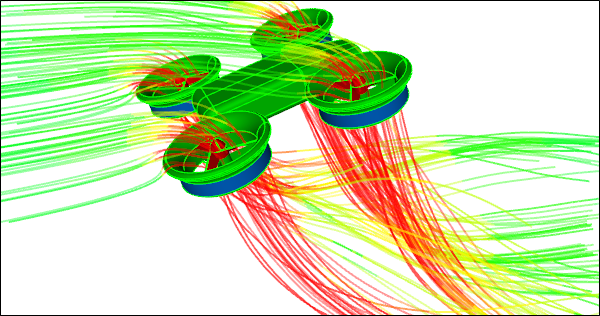
10 CFD Lessons
The beginning of a new year is always a good time to review the lessons learned from the previous year. In terms of Computational Fluid Dynamics (CFD) we had a bumper crop of advice and tips for you in 2015, so take a look and see if you missed any the first time around.
 Unconventional Quadcopter UAV CFD Simulation
Unconventional Quadcopter UAV CFD Simulation
1. Reduced Complexity 3D Models for CFD
Reduced complexity 3D model for CFD is a great way to avoid getting bogged down in details that are not relevant for a simulation. 3D video games and 3D animation applications have been using reduced complexity 3D models combined with texture maps to present rich visuals since the dawn of the digital age. These models and the concepts to build them can be extremely useful for CFD. Read more >>
2. Fluid Device Design is Like Herding Cats So Let CFD Help
Where the action of a fluid is the primary concern in the design of a device, e.g., a cyclone, sometimes it can seem that fluid is going out of its way to be difficult - a lot like trying to herd cats. Fluid device designers have to carefully match geometry to flow rates to meet performance criteria. However, if they were to rely solely on physical testing, then their task is that much harder and more costly because they can't easily visualize the flow behavior. Let CFD save you money and time as a supplement to physical testing. Read more >>
3. CFD Helps Unconventional Concept Designs Succeed
When you find yourself tasked with the design of something unconventional, then CFD is here to help. For instance consider the aircraft industry. It used to be that the dominant type of aircraft required a pilot and therefore a cockpit with a good view of the world. Then Unmanned Aerial Vehicles (UAVs) went mainstream and everything changed. Read more >>
4. Weak and Strong Form CFD
If you are given production-ready detailed CAD geometry (nuts, bolts, and all) for CFD analysis you have to ask yourself, is this really an engineering endeavor or a marketing exercise? Given the effort to produce a complete, detailed CAD model, it is unlikely that any significant changes will be looked upon favorably. Instead you will likely find that CFD is to be used in its weakest form, i.e., Colorful Fluid Dynamics (CFD) for marketing. Read more >>
5. Learn CFD Through Play
Rather than wait until your project schedule dictates it's time for CFD analysis, allocate time now to 'play' with CFD. By 'play' I mean construct simple geometry and keep your cases relatively small, so you can get familiar with the basic features of your particular CFD software in a timely manner. Read more >>
6. Get Started With CFD
New to CFD? Then you've come to the right place. Becoming productive in CFD can be a daunting task. However, as with all long term goals, if you break it down into smaller, achievable tasks, in no time you'll be up to speed and ready for production level work. Assuming you are familiar with the fluid dynamics of your application, then let's begin. Read more >>
7. DIY CFD
If fluid flow is a primary driver for your design project then CFD is likely to be a cost effective way to help meet your goals. You could outsource your CFD to consultants, but in the long run it usually pays to do it yourself. Read more >>
8. CFD Prefers NURBS Over STL
Let me explain why, given the option, you should prefer analytic geometry (e.g., NURBS) over faceted geometry (e.g., STL) for CFD. Read more >>
9. CFD Geometry Creation
Given the option, it is often better to create geometry specifically for your CFD simulations. It is even better if your CFD system supports geometry creation. Then you can stay within a single integrated simulation environment for your entire task without the need to learn or purchase additional software packages. Read more >>
10. Physics and Solver Setup for CFD
A CFD simulation requires that you configure physics and solver values based on your knowledge of your fluid application. Primarily this setup stage requires defining your fluid state, reference values (e.g., velocity), initial values, boundary conditions, and solver parameters. Follow along as I describe each stage and relate it to a CFD simulation of the external airflow over an idealized car. Read more >>
- Richard Smith's blog
- Login to post comments
Select Language
Recent blog posts
- CFD Simulates Distant Past
- Background on the Caedium v6.0 Release
- Long-Necked Dinosaurs Succumb To CFD
- CFD Provides Insight Into Mystery Fossils
- Wind Turbine Design According to Insects
- Runners Discover Drafting
- Wind Tunnel and CFD Reveal Best Cycling Tuck
- Active Aerodynamics on the Lamborghini Huracán Performante
- Fluidic Logic
- Stonehenge Vortex Revealed as April Fools' Day Distortion Field

